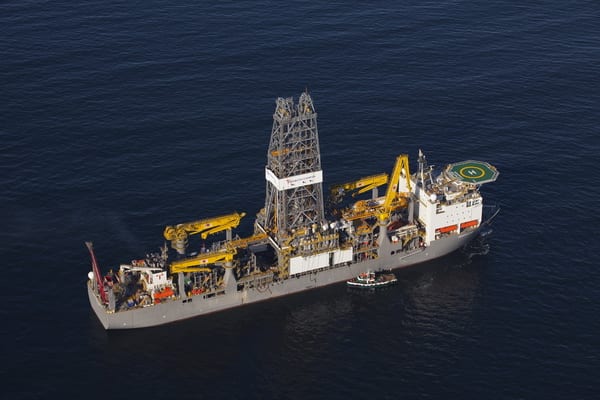One year before the giant Liza discovery…
The data from the well logs looked promising, and a restrained optimism began to build among small groups of specialists at ExxonMobil’s north Houston campus, at its Georgetown venture office and aboard the drillship Deepwater Champion 120 miles off the coast of the South American nation of Guyana.
Kerry Moreland and a team of other ExxonMobil geoscientists had been tracking the progress of the Liza-1 well since crews started drilling in March 2015; it was now early May, and the drillers were closing in on the reservoir section.
“A small team worked more than a year designing and executing a plan that had now brought us to the brink of what could be a major discovery,” said Moreland, Guyana basin project manager. “The suspense and excitement continued to grow by the hour as the drill bit approached the top of the predicted reservoir section.”
While the team in Houston prepared to analyze the real-time results soon to come, Moreland boarded an early flight to Guyana the morning of Monday, May 4, to be at the well site the moment the first results came in.
“When I finally arrived in Georgetown, the drillers had just entered the reservoir section some 11,000 feet beneath the seabed,” Moreland said. “I was too excited to sleep, even for a few hours, and was at our helicopter base at dawn. By 9 a.m., I was aboard the ship.”
By this time the Exploration and Drilling teams in Houston, as well as those in the small Guyana venture office, felt they could be witnessing something big, as the well logs showed the intermittent presence of hydrocarbons within the target.
“We didn’t know at that point what we had, since we were drilling in and out of several sands,” said Jeff Simons, ExxonMobil Guyana country manager. “Drilling continued through the night, and on the morning of May 6, it became clear we’d found a column of hydrocarbons extending more than 295 feet. That’s big, really big.”
Onboard the Deepwater Champion, Moreland and the wellsite geologists had the benefit of something else that supported the significance of the find: the drill cuttings from the reservoir itself.
“We analyzed the rock fragments in a small lab onboard the ship, both for rock type and for what we call ‘shows,’” Moreland said. “That analysis, along with the well logs acquired while drilling, suggested the potential for a significant volume of high-quality oil.”
A longshot
The odds were against it. The Stabroek block that ExxonMobil acquired rights to explore from the Republic of Guyana is 6.6 million acres. Water depth at the site exceeds a mile. There had never been a well drilled anywhere on the block. The 22 wells drilled by other companies since the 1970s on the coastal shelf outside the southern boundaries of the block had all proved noncommercial.
“Geologically, the well was quite risky,” Moreland said, “with a low probability that it would turn out to be successful. It was a true frontier wildcat well.”
But she went on to explain that the location of the Liza-1 well held particular interest for the explorers, since initial seismic data and geologic analysis of the region “suggested the presence of sediment fairways transporting sandstone reservoirs into the basin. In addition, oil and gas shows in previously drilled wells closer to the coast indicated a working hydrocarbon system potentially extending farther offshore into the Liza area.”
What happened next?
The discovery was just one step. Oil and gas move through tiny holes or pores in a rock formation. The characteristics of these rocks and fluids need to be determined in order to assess how best to develop the resource. “By integrating seismic, well and rock data, we can start to assess how hydrocarbons will flow out of the reservoir and determine the optimal well placement,” said Moreland.
So, while ExxonMobil technical experts analyzed the initial well data to evaluate the Liza discovery, the exploration team focused on evaluating the remainder of this very large block. The largest proprietary 3-D seismic survey in the company’s history got underway on the Stabroek block. Two seismic vessels acquired data over approximately 6,500 square miles, an area larger than the state of Connecticut.
A little more than a year after the initial discovery, in June 2016, ExxonMobil drilled the Liza-2 well, located about two miles from the Liza-1 well. Liza-2 also showed high-quality oil from the same sandstone reservoirs seen in the Liza-1 well.
ExxonMobil has gone on to make a total of 13 discoveries at the Stabroek block amounting to more than 5.5 billion barrels of recoverable oil.
Source: Energy Factor




